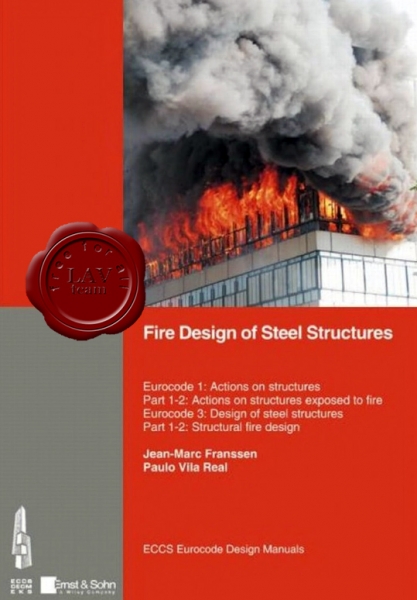Jean-Marc Franssen, Paulo Vila Real - Fire Design Of Steel Structures
Eurocode 1: Actions on structures. Part 1-2 – General actions – Actions on structures exposed to fire
Eurocode 3: Design of steel structures. Part 1-2 – General rules – Structural fire design
Wiley, 2012
pdf, 447 pages, english
ISBN: 978-92-9147-099-0

Designing for fire is an important and essential requirement in the design process of buildings and civil engineering structures. Within Europe the fire resistance requirements for buildings are specified in the national Building Regulations. All buildings must meet certain functional requirements and these are usually linked to the purpose and height of the building. For the purpose of this publication, the most important requirement is for the building to retain its stability for a reasonable period. This requirement has traditionally been linked to the required time of survival in the standard fire test. The most common method of designing a steel structure for the fire condition is to design the building for the ambient temperature loading condition and then to cover the steel members with proprietary fire protection materials to ensure that a specific temperature is not exceeded. Although this remains the simplest approach for the majority of regular steel framed buildings, one of the drawbacks with this approach is that it is often incorrectly assumed that there is a one to one correspondence between the survival time in the standard fire test and the survival time in a real fire. This is not the case and real fire can be more or less severe than the standard fire test depending on the characteristics of the fire enclosure.
The fire parts of the Eurocodes set out a new way of approaching structural fire design. To those more familiar with the very simple prescriptive approach to the design of structures for fire, the new philosophy may appear unduly complex. However, the fire design methodology in the Eurocodes affords the designer much greater flexibility in his approach to the subject. The options available range from a simple consideration of isolated member behaviour subject to a standard fire to a consideration of the physical parameters influencing fire development coupled with an analysis of the entire building.
The Eurocode process can be simplified in to three components consisting of the characterisation of the fire model, a consideration of the temperature distribution within the structure and an assessment of the structural response to the fire. Information on thermal actions for temperature analysis is given in EN 1991-1-2 and the method used to calculate the temperature rise of structural steelwork (either protected or unprotected) is found in EN 1993-1-2. The design procedures to establish structural resistance are set out in EN 1993 but the actions (or loads) to be used for the assessment are taken from the relevant parts of EN 1991.
This publication follows this sequence of steps. Chapter 2 explains how to calculate the mechanical actions (loads) in the fire situation based on the information given in EN 1990 and EN 1991. Chapter 3 presents the models that may be used to represent the thermal actions. Chapter 4 describes the procedures that may be used to calculate the temperature of the steelwork from the temperature of the compartment and Chapter 5 shows how the information given in EN 1993-1-2 may be used to determine the load bearing capacity of the steel structures. The methods used to evaluate the fire resistance of bolted and welded connections are described in Chapter 7. In all of these chapters the information given in the Eurocodes is presented in a practical and usable manner. Each chapter also contains a set of easy to follow worked examples.
Chapter 8 describes a computer program called ‘Elefir-EN’ which is based on the simple calculation model given in the Eurocode and allows designers to quickly and accurately calculate the performance of steel components in the fire situation. Chapter 9 looks at the issues that a designer may be faced with when assessing the fire resistance of a complete building. This is done via a case study and addresses most of the concepts presented in the earlier chapters. Finally the annexes give basic information on the thermal and mechanical properties for both carbon steel and stainless steel.
The concepts and fire engineering procedures given in the Eurocodes may seem complex to those more familiar with the prescriptive approach. This publication sets out the design process in a logical manner giving practical and helpful advice and easy to follow worked examples that will allow designers to exploit the benefits of this new approach to fire design.